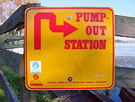
General Description
Vessel wastewater discharges are primarily regulated by EPA's NPDES Vessel General Permit (VGP). Two types of watercraft-unique wastewater are ballast water and bilge. Bilge is the lowest compartment of a ship where the two sides meet and where water collects from rough seas, rain, minor leaks in the hull. Bilge is where oil, solvents, detergents, chemicals, urine, and other wastes that have accumulated while out at sea. Ballast water is taken onboard for stability prior to a voyage and then released into the water once the destination is released.
Summary of Federal Requirements
The EPA has issued two NPDES General Permits related to discharges of wastewater from vessels/ships/boats/watercraft. Neither permit applies to recreational or military vessels.
Vessel General Permit (VGP)
The currect VGP is effective from 19 December 2013 to 18 December 2018.
The VGP applies to discharges incidental to the normal operation of all non-recreational, non-military vessels of 79 ft. or greater in length which discharge in waters of the United States. The types of vessels covered under the VGP include commercial fishing vessels, cruise ships, ferries, barges, mobile offshore drilling units, oil tankers or petroleum tankers, bulk carriers, cargo ships, container ships, other cargo freighters, refrigerant ships, research vessels, emergency response vessels, including firefighting and police vessels, and any other vessels operating in a capacity as a means of transportation.
Prior to discharging wastewater vessels of 300 gross tons or more or that have the ability to hold or discharge more than eight cubic meters of ballast water must submit a Notice of Intent (NOI) using the EPA eNOI system to obtain permit coverage. Vessels less than 300 gross tons and that do not have the capacity to hold or discharge more than eight cubic meters of ballast water are not required to submit an NOI. Instead, operators of these vessels must complete a Permit Authorization and Record of Inspection (PARI) Form and keep a copy of that form onboard the vessel at all times.
Part 1 of the permit contains general conditions, authorized and ineligible discharges, and explains who must file a notice of intent to receive permit coverage. Part 2 of the permit discusses effluent limits applicable to vessels. Part 3 of the permit lists required corrective actions that permittees must take to remedy deficiencies and violations. Part 4 of the permit lists visual monitoring, self-inspection, and recordkeeping and reporting requirements. Due to specific concerns arising from certain types of vessels, in Part 5 of the permit, EPA has identified select categories of vessel types that have supplemental requirements. States, territories, and certain Tribes have the authority to require additional requirements.
Small Vessel General Permit (sVGP)
EPA issued the sVGP on 10 September 2014 for the control of incidental discharges for vessels less than 79 feet in length. However, as the result of legislation, these smaller vessels are not required to obtain coverage under that permit until 18 December 2017, except for any ballast water discharges. That legislation also exempted commercial fishing vessels of all sizes from having to obtain NPDES permit coverage for those incidental discharges, except ballast water, until 18 December 2017.
The current permit is effective from 19 December 2014 to 18 December 2019 (i.e., five years) and provides NPDES permit coverage for incidental discharges from non-military, non-recreational (commercial) vessels less than 79 ft. in length.
To obtain coverage under the sVGP vessel owners must complete a Permit Authorization and Record of Inspection (PARI) Form and maintain a copy onboard.
The permit is structured similar to the VGP and compliance requires meeting the standards and limitations outlined in the permit.
Summary of State Requirements
The Clean Water Act allows states to provide different, more stringent requirements for discharges into their State's waters. These requirements can be found in Part 6 of the VGP.
Laws and Statutes
Clean Water Act



